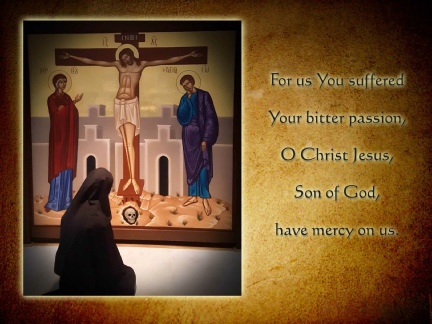




Our Monastic Consecration as the Way of Imitating Jesus
“We have no lasting city here below, but look forward to one that is to come” (Heb. 13:14-16).
The evangelical basis of consecrated life is seen in the relationship which Jesus, in His earthly life, established with some of His disciples. He called them not only to welcome the Kingdom of God into their own lives, but also to put their lives at its service, to leave everything behind, and to closely imitate His own way of life.
To follow Jesus’ way of life and as a result to make it our own, the set up of our own life as the contemplative community is extremely important. The masters of the monastic tradition of both the East and the West always considered such a set up as indispensable for achieving the monastic ideal. Therefore, in our everyday life in the monastery, the “school for the service of the Lord,” we base our life on the following five pillars or observances of the monastic life which guide us on the path of our vocation.
The first and the most basic is the withdrawal from society. A life of prayer requires silence and solitude which also Jesus himself sought in His own prayer. The authentic withdrawal does not make a person alone or lonely, instead it produces a new presence to the world. In solitude, silence, and union with Jesus we profess the eschatological dimension of Christian life, and give witness of the world to come, which is an element pertaining especially to the Eastern monasticism.
The second pillar of monastic life is life in community (coenobitic life). Even though we dedicate ourselves to contemplation of divine realities in solitude, we do it in community among other members of the same monastic family. The life in community is a continual witness to the presence of Jesus in the midst of His people (Matt. 18:20).
Formation of a Nun in the Holy Annunciation Monastery
Formation at Holy Annunciation Monastery follows directives of the Apostolic See as given in recent documents for the monasteries of the contemplative life Vita Consecrata and Cor Orans and draws abundantly on the founders of the early monasticism of Eastern and Western traditions. We cherish the contemplative monastic tradition of St. Benedict which resonates with the monasticism of the undivided Church. Underlying principle of formation is to help each nun to grow in her vocation to contemplative life in the monastery where solitary communion with God is closely united with sisterly coenobitic life under obedience to Hegumena.
The third pillar of the monastic life is austerity that includes fasts, penitential attitude, and frugality. If we want to follow the gospel path of Christ we must conform ourselves to his example and share in his mission of salvation. This means that we must renounce our very selves.
The fourth pillar of the monastic life is manual work. By his very example Jesus showed us to love manual labor, earning our living by our own efforts. Manual work was a part of monasticism since its very beginning. The monastics in the desert practiced simple crafts, like weaving baskets, to provide for their lives.

Hard and redeeming work is a means of providing a livelihood for us and for others, especially the poor. It expresses solidarity with all workers. Moreover work is an occasion for fruitful asceticism that fosters personal development and maturity. It promotes health of mind and body and contributes greatly to the unity of the whole community.
Even though the work that supports the community is important we shall always remember that it is secondary to the true work of a monastic community which is to bring its members through faith, hope and charity to personal union with God in Christ.
The fifth pillar: In solitude and silence, by listening to the Word of God, participating in divine worship, personal asceticism, prayer, mortification and the communion of sororal love, we shall direct our whole lives and activities to the contemplation of God. By doing that we offer a testimony of the Church’s love for her Lord, and contribute, with hidden apostolic fruitfulness, to the growth of the People of God.
Prayer was essential to Jesus’ way of life. He is a model, teacher, and mediator of Christian prayer. By teaching his disciples Our Father Jesus raised their prayer to the dignity of sharing in His filial conversation with His Father in the Holy Spirit (Luke 11:2-4). As a consequence, prayer must be the first priority in the life of the monastic community and in the personal commitment of every nun. As St. Teresa stated, the prayer without ceasing is a foundation of the nun’s life and her primary activity.
The path of sanctification begins with the birth to the new life in the Sacrament of the Baptism. The monastic habit given to her in successive stages of the monastic profession becomes a visible sign of her advance on the path of that journey of life already begun at Baptism, the journey back to the Father.
The aspirancy or candidacy is a period of the initial or introductory knowledge of place, the Nuns, the life. This is a period of being a “pilgrim guest.” The time of aspirancy may last from three months to two years and is usually succeeded by the formal stages lasting up to 10 years. Rassophore (novice), Stravrophore (initial profession), Schemenun (final commitment and membership in the monastic Synaxis).

The Monastic Oblature is part of the Monastic Community of Holy Annunciation Monastery.
Holy Annunciation Monastery
403 West County Road
Sugarloaf, PA 18249
Phone: 570-788-1205








